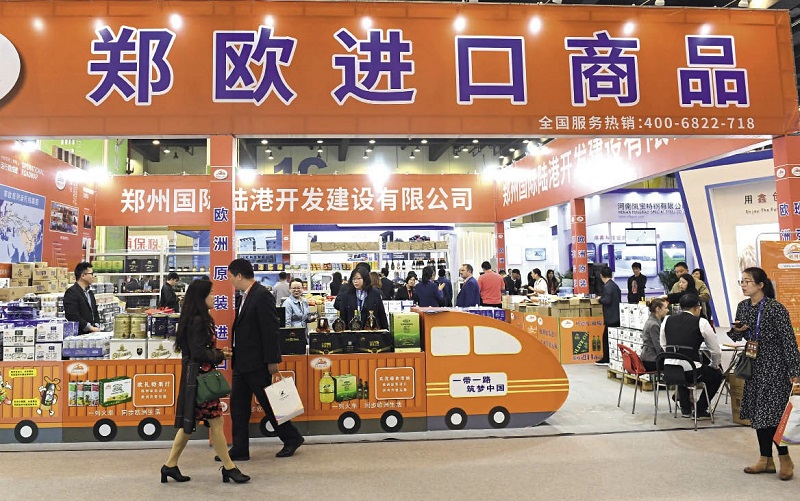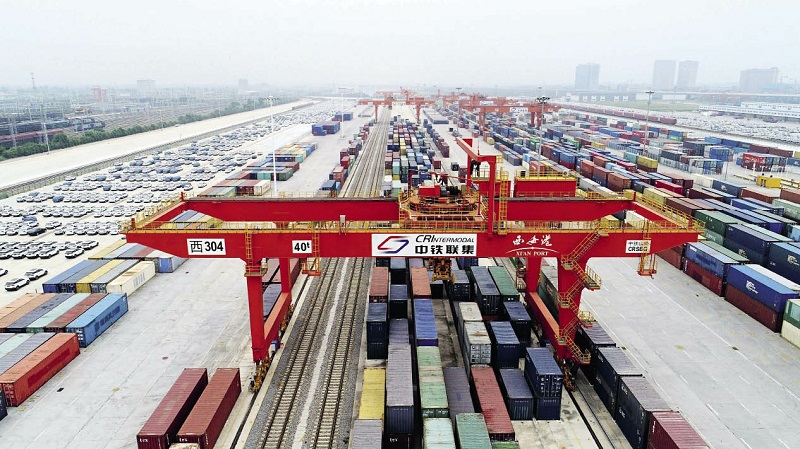The Tuanjiecun container depot in Chong-qing, a mega city in southwestern China, is a hive of activity, where overhead traveling cranes lift containers onto trains bound for Duisburg in Germany. Ten years ago, the first train of the Chongqing-Xinjiang-Europe international line departed here on March 19, 2011. It marked the launch of the regular express freight train service between China and Europe, known as the China-Europe Railway Express, injecting new vigor into the ancient Silk Road.

The section for goods imported through the China-Europe Railway Express at the 13th China Henan International Investment and Trade Fair on April 8, 2019.
A Channel for Economic Cooperation
The China-Europe Railway Express serves China, Europe, and the countries in between. As the Belt and Road Initiative (BRI) is moving toward higher-quality development, this train service has become a key channel for economic cooperation between China and other countries along the BRI routes.
Connecting Chongqing with cities in Kazakhstan, Russia, Poland, and Germany, the Chongqing-Xinjiang-Europe international railway has cut the rail transport period between western China and Europe to 13 days.
Zhang Xin, the 50-year-old chief of the Tuanjiecun Station, still remembers the departure of the first Chongqing-Xinjiang-Europe train as if it happened yesterday, because it was him who gave the “go” instruction. At that time his station set the long-term goal of sending off one train to Europe every day, but he was not optimistic it could be done. Today, a dozen trains pull in or set off from the station every day. “No one expected such strong growth,” said Zhang.
Along with the increase in the number of trains commuting between the two continents, the variety of goods they carry and the total volume and value of trade have also grown steeply. These trains transport China-made laptops, displays, printers, machines, and parts to Europe, and bring back timber, pulp, milk powder, high-end equipment, and automobiles manufactured in Europe, greatly reinforcing trade ties between the two sides. The value of the goods shipped along the Chongqing-Xinjiang-Europe railway has been the largest in China for years.
The China-Europe Railway Express has boosted growth in Chongqing’s export-oriented industries by about 30 percent. More than half of the world’s top 500 companies have set up operations in the city. The number of international containers going through Tuanjiecun is rising by at least 10 percent year-on-year on average. Chongqing and neighboring Chengdu have thus emerged as leading global hubs of electronic and information industries. What’s more, the entire western China is now better integrated into the international industrial landscape.
Duisburg, 11,000 kilometers away from Chong-qing, has also reaped the benefits of the international freight train service. The defunct iron and steel works in its Reinhausen District has been remolded into a booming logistics park, and its DIT freight terminal is now a major distribution center along the China-Europe railway. According to Johannes Pflug, a local official in charge of China affairs, the train service has created more than 6,000 jobs in the city. Kuehne & Nagel, a global transport and logistics company, established one of Europe’s largest logistic centers in Duisburg in 2019.
In his reply to an email sent by Xinhua reporters, Daniel Thomas, manager of the Duisburg Intermodal Terminal (DIT), wrote, “We saw loads of food, wine, and other consumer goods in the containers bound for China, and believe Chinese customers can buy stuff from Europe with ease. European countries can therefore share in the opportunities of the Chinese market.”
A Revived Silk Road
The dynamics brought about by the Chongqing-Xinjiang-Europe route is a fine example of the strong growth of the China-Europe Railway Express. This service was born out of the growing demand for bilateral trade and investment, as well as further opening up of inland China, and has expanded as the BRI reaches new destinations.
Since it was first proposed by Chinese President Xi Jinping in 2013, the BRI has become a banner for world peace and development through extensive consultation, joint contribution, and shared benefits. With the participation of 140 countries and 32 international organizations, it is now the world’s largest platform for transnational cooperation.
Data from China’s Ministry of Commerce show that China’s direct investment in 63 countries along the BRI routes added up to US $117.31 billion between 2013 and 2019. Even in 2020, at the peak of the COVID-19 pandemic, Chinese enterprises made US $17.79 billion direct investment in non-financial sectors in 58 countries along the BRI routes, a year-on-year increase of 18.3 percent; trade in goods between China and its BRI partner countries also edge up by 0.7 percent to reach US $1.35 trillion, which accounts for 29.1 percent of the value of China’s total foreign trade. The World Bank estimated that if fully implemented, BRI transport projects could increase trade between 1.7 and 6.2 percent for the world, and increase global real income by 0.7 to 2.9 percent.
As the BRI gains traction, freight train services between China and Europe continue to thrive. Over the past decade, the annual trips of freight trains between the two destinations has increased from 17 to more than 12,000 in 2020, with the total number exceeding 40,000. The total value of goods transported via this means tops US $200 billion.
In an imported foods store in Qingfeng Street, Zhengzhou, capital of Henan Province 1,100 kilometers from Chongqing, a woman surnamed Wang browsed the shelves stocked with beer from Germany, chocolate from Switzerland, and nuts from France. There were even various brands of imported ice-cream in the freezer. “I can buy imported goods close to my home whenever I feel like it. It is great,” she said.
Since the freight train service was opened in Chengdu, electronics manufacturer TCL has increased exports year by year. Now up to 70 percent of its television sets are sold to Europe. “The advantage of train freight is obvious. Sea transport takes about 40 days, while it only takes 15 to 18 days by rail,” said a logistics manager of TCL.
Since the outbreak of COVID-19, the role of the China-Europe train freight service in enhancing global connectivity has become more prominent. Nearly 12 million items of COVID-19 infection control supplies totaling 94,000 tons have been sent to Europe by rail, helping people around the world in their fight against the deadly virus.

The departure station of China-Europe Railway Express (Xi’an), located at Xinzhu Station on the north ring line of the Xi’an hub, is renamed as Xi’an International Port Station on April 1, 2021, marking the further integration of the Xi’an International Port District with the global railway network.
A Bright Future
Data from the National Development and Reform Commission show that during the first half of this year there were 7,323 freight train trips between China and Europe, up 43 percent over the same period of 2020. The cargo transported totaled 701,000 TEU cargo units, up 52 percent. And most companies engaged in the operation of the China-Europe freight train services have extended the reach of their services. At present there are 73 routes of such trains, connecting 168 cities in 23 countries. Starting with the singular Chongqing-Xinjiang-Europe line, China-Europe Railway Express now runs a sprawling network.
More improvements, however, need to be made to the service. One is to upgrade the goods transported. Ma Bin, a deputy research fellow at the Institute of International Studies, Fudan University, said that the China-Europe Railway Express should always focus on quality in its development, have a clear understanding of its position in the market, improve planning for its routes, and enhance the performance of its operators. Its development should be aligned with that of industries along its routes, he added.
Katarina Zaki, a researcher at the Institute of International Politics and Economics of Serbia who studies the BRI, suggested improvements in three areas — track gauge, loading/unloading speed, and administrative procedures for cross-border freight.
At a recent meeting, the office of China’s leading group on advancing Belt and Road Initiative development put forward new requirements for the train service, including increasing the scale and profits of the operation, maintaining a market-based operational mode under government guidance, breaking bottlenecks in China and other regions along the routes, and coordinating development across regions involved.
“The China-Europe Railway Express is a key conveyor in international industrial and supply chains, and takes on a historic mission in promoting the new development paradigm of ‘dual circulation.’ It has an important role to play and will embrace huge development opportunities,” said Ning Jizhe, deputy head of the National Development and Reform Commission, who is also deputy chief of the office of the leading group on advancing Belt and Road Initiative development. He called on its operators to ride on the momentum which the service has built and increase its competitiveness.
Under its 14th Five-Year Plan, China will open its market wider to international companies, allowing foreign investment to enter more industrial and service sectors. This move will further boost trade ties with Europe and business for the China-Europe Railway Express.
As more countries sign up for the BRI and its network expands, the China-Europe Railway Express will build closer trade ties between the two sides, which will advance economic globalization and allow people along the routes to share in the fruits of development.